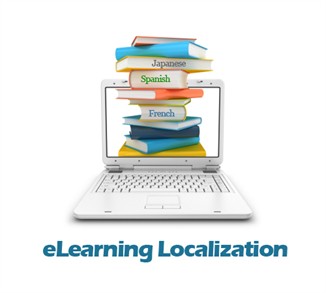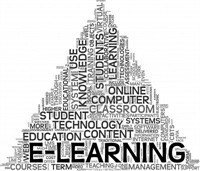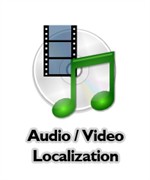eLearning and Localization – An Education
This blog will focus on eLearning localization, its evolution from a simple educational experiment to a dynamic, virtual training platform with a global target audience. Blame it on the rise of globalization, but companies are focusing more and more on the localization of their training courses and eLearning material in order to ensure that their growing global work force receives adequate training and the necessary education to support global market expansion.

eLearning History and Evolution
eLearning has come a long way from the early 1960’s when Stanford University psychology professors Patrick Suppes and Richard C. Atkinson first experimented with using computers to teach math and reading to elementary school children in Palo Alto, California. By the year 2000, the worldwide eLearning industry had been estimated to be worth over $48 billion according to even the most conservative estimates.
At the beginning, eLearning systems were based on Computer-Based Learning (CBL) and Training which were conducted in a quite traditional teaching style whereby the eLearning system was meant to simply transfer knowledge, as opposed to more recent systems that were based on Computer Supported Collaborative Learning (
CSCL) which were based on the premise of developing knowledge collaboratively as the name indicates.
The emergence of Web 2.0 also prompted an evolution in the way eLearning was conducted and delivered. Until then conventional eLearning systems were based on instructional packets delivered via training assignments which were then evaluated by the teachers and instructors giving the training. In contrast eLearning 2.0 assumes that knowledge is socially constructed and therefore places emphasis on social learning and utilizes social software such as blogs, wikis and podcasts – a phenomenon that has also been referred to as Long Tail Learning.
Social networks have also been used to foster online learning communities around specific subjects in the areas of test preparation and language education. For instance Mobile Assisted Language Learning (MALL) is a term used to describe using handheld computers or cell phones to assist in language learning. Unfortunately not everyone has caught up with social networking trends so there is still significant room for growth.

eLearning Deployment
So how exactly is eLearning developed and delivered? A learning management system (LMS) is software used for delivering, tracking and managing training. LMSs range from systems for managing training/educational records to software for distributing courses over the Internet and offering features for online collaboration. LMS provides multiple benefits to instructors and administrators by offering the ability to track time spent on a specific task, scoring and completion rates, and overall progress and areas of concern that may require additional training/instruction. Employees on the other hand can log on to the LMS to submit assignments and to access the course syllabus and lessons.
eLearning comprises all forms of electronically supported learning and teaching, and applications include web-based and computer-based training which can be conducted via the internet, intranet/extranet or CD-Rom and include media in the form of text, images, animation (Flash) and/or streaming video and audio. Alternatively more traditional delivery methods may be conducting training via WebEx displaying simple PowerPoint slides in absence of an LMS.
The eLearning tools becoming more and more prevalent in the market are rapid eLearning development tools which make course development faster and some aspects of it much easier and less costly. Among them are two of the most widely-used and popular ones: Articulate Studio and Adobe Captivate.
Some common features of both tools:
- Quiz and/or Assessment Development
- LMS connectivity
- Flash-based output
- Learning interactions
Albeit their sophistication these tools are often purchased with the expectation that anyone will be able to use them to create great eLearning courses but as the tools become increasingly complex and add more and more features for developers and learners there is no substitute for knowing how to use them efficiently and effectively and the more skilled and experienced the user or creator is in using these tools, the better the results will be.
eLearning Localization Services
Now that you have successfully developed and deployed your US-based training how do you expand training and effectively train your global work force?

Traditional global training courses may have included the translation services of posters, manuals, surveys, employee handbooks, flash cards and curricula that outline training schedules and unit plans that cover actual content, but more and more global training now also incorporates eLearning and web-based training:
1. Module components that require localization may include training videos which will require voicing and/or subtitling in addition to the localization of the actual scripts. Check our Audio and Video Translation Services for more information.
2. Flash presentations may require full localization and/or voicing audio tracks. Workarounds may have to be found when deploying training in Flash, i.e. Flash does not support Arabic language script which requires additional steps of graphic localization for the text.
3. Most online training modules conclude with online assessments that will also require localization and may require specific encoding in order to display correctly.
4. Final testing and Online QA is critical for online content and eLearning in order to complete the full localization cycle.
A word of caution: simply translating content into the target languages spoken in the countries your global work force resides is only one part of the equation; actual training modules that share a global image and brand still have to be adapted to local audiences in order to make your global training initiatives a true win-win. On that note some of the items that deserve special attention are:
- Localization of proper names (i.e. Mc Donald’s BigMac or Dairy Queen’s Blizzard which remain in English vs. others that are localized into the target language)
- Instructions that are clearly labeled with lots of images and limited text may be easier to translate and facilitate better comprehension and less confusion for staff
- Multinational corporations typically have to modify their training material due to local worker’s laws, and may have to seek prior approval by worker’s council, etc. Keep that in mind when setting launch dates as additional time may be needed to get approval from local worker’s councils and unions
- Images need to be localized, i.e. pictures of Japanese workers for a Japanese carmaker may have to be replaced or supplemented with pictures displaying a more culturally diverse workforce in order to appeal globally
Conclusion: Regardless of the type of eLearning initiatives your enterprise launches, be it elaborate training modules in Flash or simple PowerPoint presentations, the objective – the ultimate goal – should always remain the same: train effectively, coach and mentor tirelessly, and pay attention to details. The only way to make sure your global staff represents your brand as effectively as your marketing team down the hall envisioned it is to fully immerse yourself into the unique and enriching cultural challenges and opportunities your global staff presents to your organization!
GPI, a premiere translation company, provides comprehensive localization and translation services for eLearning and training courses. Our elearning localization services team will help you translate your elearning courses and presentations in all languages.
